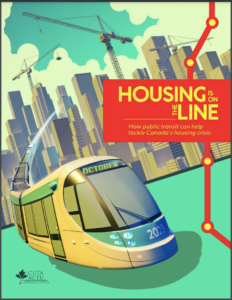The Canadian Urban Transit Association just published a report on the benefits of retaining affordable housing, and including provisions for new housing, in transit stations, nodes, and corridors. The Housing is on the Line  report makes 17 recommendations to governments under five themes: Activate Land, Evolve the Mandate of Transportation Agencies, Ensure Inclusivity, Streamline Approval Processes, and Maximize Investments.
report makes 17 recommendations to governments under five themes: Activate Land, Evolve the Mandate of Transportation Agencies, Ensure Inclusivity, Streamline Approval Processes, and Maximize Investments.
While the report acknowledges planning pitfalls like failing to upzone land near transit and lands held by private investors who take years to build, it also proposes a recommendation for provincial governments to make it easier for transportation authorities to buy and assemble lots in designated transit corridors/station areas. Example: the BC Government Act was amended to allow the BC Transportation Finance Authority to buy land to use for housing and community amenities–not only transportation projects. Provinces could also limit land speculation by allowing municipalities to buy land that has been undeveloped for a certain amount of time (the City of Coquitlam does this). For transportation authorities, developing a real estate strategy with a local municipality/region would allow long-term acquisition of properties for transit projects. Encouraging overbuilding at key locations like transit stations in very dense areas is also recommended.
Most exciting, CUTA’s report recommends a housing and transportation index be developed, and even potentially taking the lead on this badly-needed project. They also say that the federal government needs to incentivize regional transportation projects and collaboration between local governments, citing BC’s Supportive Policies Agreements (SPAs). TransLink has signed SPAs with the City of Surrey, City of Langley, and Township of Langley for the Surrey-Langley SkyTrain project with the goal to ensure that housing (including affordable housing) is built near future SkyTrain stations.
